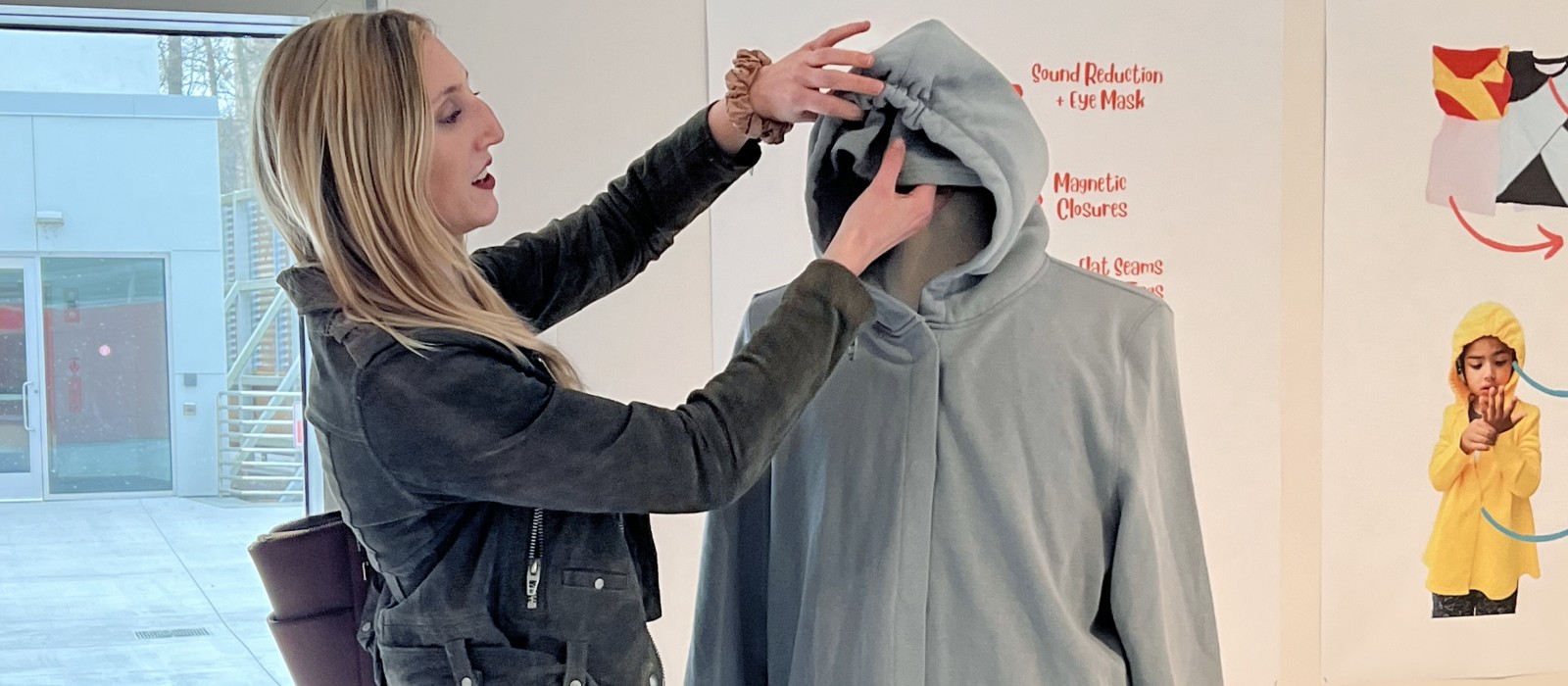
Julia DeNey ’20 demonstrates the hidden functions of a sweatshirt in the exhibit.
Most exhibits feature signs warning visitors not to touch the displays. But in the Sensory Friendly and Adaptive Fashion exhibit, visitors are encouraged to touch, fidget and experience both positive and negative stimuli.
The new exhibit is part of Cornell’s Neurodiversity Celebration Week, March 18-22, campus-wide events designed to increase awareness, understanding and acceptance of neurodiversity, challenge stereotypes and misconceptions about neurological differences and ultimately help create a more inclusive and equitable Cornell community.
“We want the public to understand more about neurodiversity and the needs of neurodivergent people while seeing the whole person,” said Florencia Ardon, neurodivergent student support program manager in Cornell’s Learning Strategies Center. “To appreciate all of the positives that come with certain neurotypes and also the inherent disability.”
Neurodiversity is a term that describes how people’s brains work, based on the concept that variation in human cognition is normal. Neurotypical individuals show typical development and socialization growing up, while neurodivergent individuals identify as having a non-typical neurotype such as autism, ADHD, learning differences, obsessive-compulsive disorder, sensory processing disorder or anxiety.
The fashion exhibit, in the Jill Stuart Gallery in the Human Ecology Building through March 22, provides examples of sensory-friendly fashion as well as items that may cause discomfort and even pain for the wearer. One corner of the gallery offers a quiet respite using items from Cornell’s sensory room, a space for Cornell students who are stressed or overstimulated to escape sensory overload.
Worry worms, hand-crocheted by a local woman, are a soft fidget that visitors are invited to take home. Fidgeting has been known to improve attention and provide self-regulation. Twiddle muffs are colorful handmade garments using textured yarns to provide sensory stimuli for people experiencing dementia.
The exhibit is a collaboration between Ardon and Catherine Blumenkamp and Mardelle Shepley of the Department of Human Centered Design. Visitors will likely identify with something in the exhibit that bothers them, from itchy tags to stringy socks, a reminder that sensory aversion or preference is not a choice.
Student engagement spurs entrepreneurship
Several of the items in the exhibit are from Sense-ational You, a clothing brand that Julia DeNey ’20 founded to bring recognition and acceptance to those with autism spectrum disorder (ASD) and sensory processing disorder (SPD) into the fashion industry.
When DeNey was a student in Cornell Human Ecology (CHE), she volunteered with her sorority at the Racker Center, an organization supporting individuals with disabilities and their families in Tompkins, Cortland and Tioga counties. As she grew to know the children, parents and staff in the autism preschool room, they began to share stories of clothing challenges.
DeNey, who majored in fashion design, began an independent study project. Over a year and a half, she developed prototypes for the garments that are now central to her company’s brand.
“My designs provide comfort and support on the go for individuals with ASD or SPD,” said DeNey.
For example, a colorful t-shirt on display in the exhibit has a hidden compression liner. Compression provides tactile input to the body, calming the central nervous system, as well as postural support. Soft fabrics, flat seams and printed tags are universal to all of DeNey’s designs. Magnetic closures serve a dual-purpose: independent dressing for those with fine-motor delays and a built-in fidget.
Accommodation provides universal benefit
Universal design is the concept that items or environments that are designed for people who are marginalized ultimately help everyone who uses them. A common example is the curb cut, which was designed to allow wheelchair users to use sidewalks across street intersections and is also convenient for travelers pulling luggage and parents pushing strollers.
Another example is in DeNey’s collection – a hooded sweatshirt that features both noise-reducing material and an eye flap in the hood for those sensitive to environmental stimuli, which would make a great travel garment for airline passengers.
“We all have individual preferences with regard to our environment – whether it is the intimate environment of the clothes we wear or the walls around us,” said Shepley, architect and professor. Shepley’s research brings flexibility and comfort to environments like schools and hospitals so that they adapt to and support the needs of diverse users.
“On any given day, our tolerance for stimuli in our environment may vary depending on our emotional state or the events happening in our lives.”